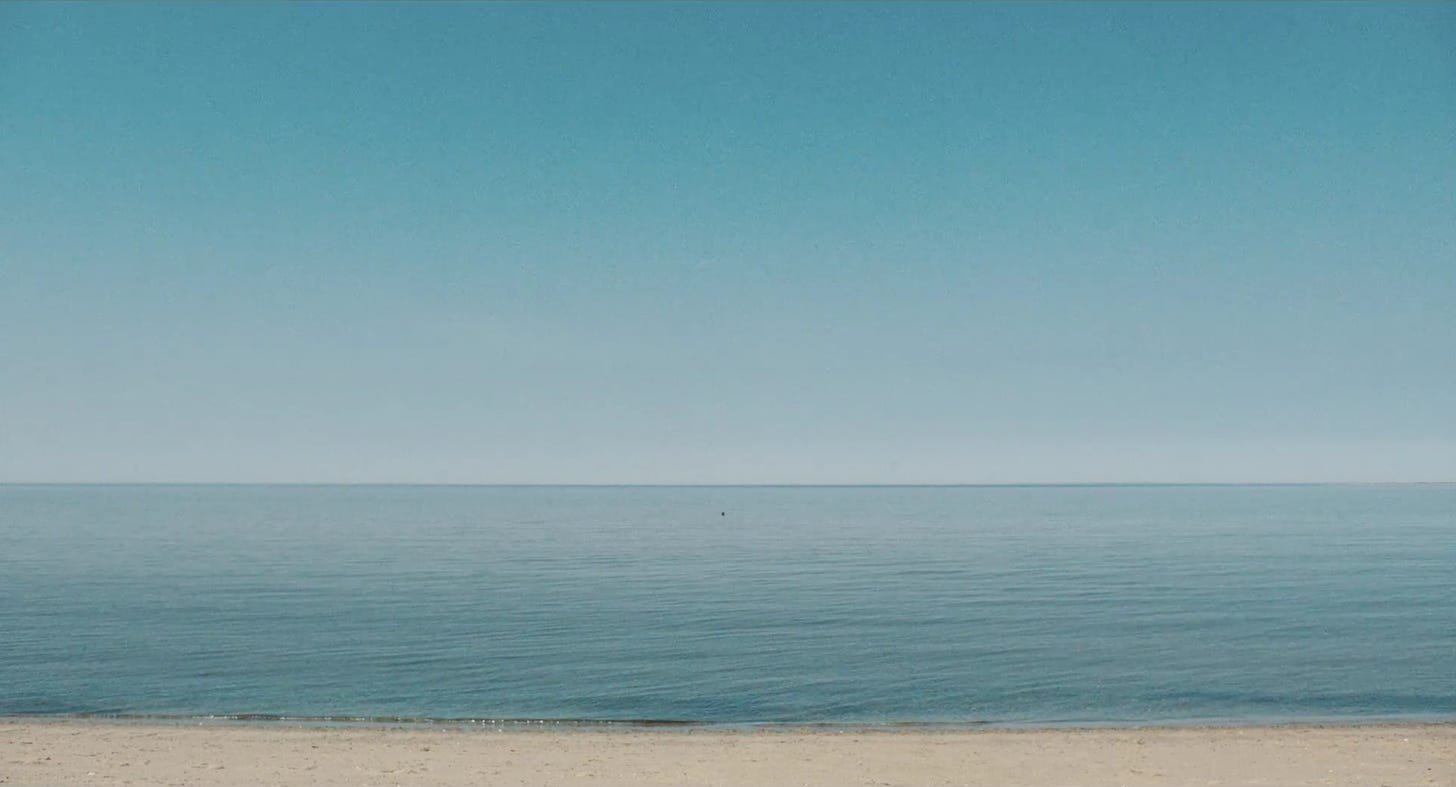
Mitch goes for a swim, from The Beach House (2019).
Welcome to the second annual Haunted Palace, the spooktacular Halloween edition of this newsletter, which should give you a good scare. You can read last year’s edition here. Also, there will be spoilers for the movie The Beach House ahead.
Jeffrey A. Brown’s 2019 indie horror movie The Beach House has probably become best known for a rather gross scene involving improvised foot surgery, but one of its most unsettling moments happens before things get quite so bad for its characters. Kindly baby boomer Mitch, played by Jake Weber with a perfect mix of forced optimism and anxiety, is sitting on the beach with our younger protagonist Emily, and begins to lose his grip on things. He and his wife Jane, who is terminally ill, wanted to have one last visit to their favorite vacation spot, but at this point in the movie it’s becoming clear that something is very wrong with the water and the air surrounding them, making the people sharing the titular beach house increasingly sick and disoriented.
After some sad reflection, Mitch gets up, says “Fine fine, everything is fine. I think I’ll go for a swim,” walks into the beautiful blue ocean, swims out until he is just a tiny black dot (see above), and then he disappears and never comes back.
This is just one of the fun ways in which the four main characters, pointedly divided by a generation, come to terms with the realization that their peaceful vacation environment—starting with the food, then the water, and finally the air—has turned on them. The culprit, it’s revealed somewhat ambiguously toward the end of the film, is some creepy glowing microbes released from the bottom of the ocean as a result of its warming, infecting animal life and causing things like really gross bathroom problems, decaying skin, and sort of turning into a zombie.
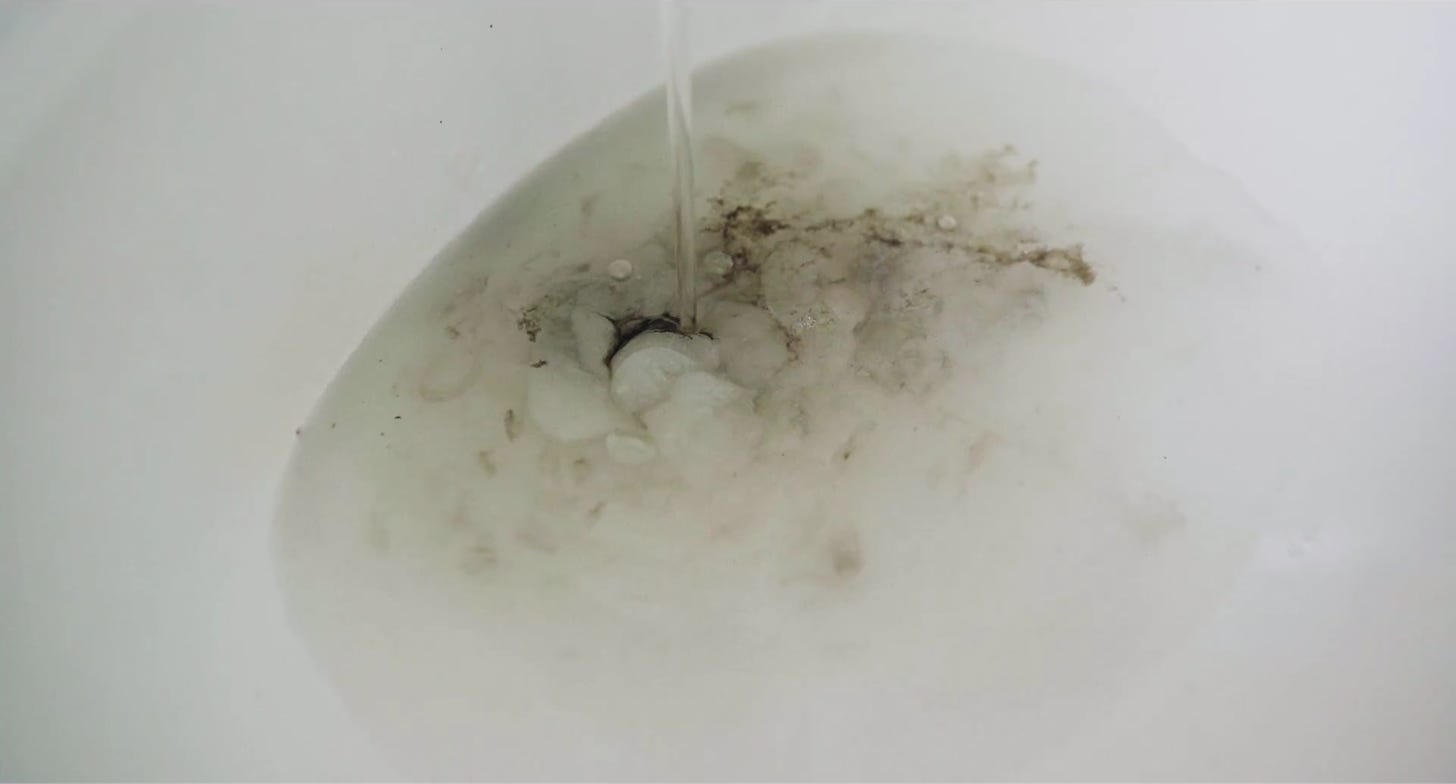
You’re going to want to run that through a Brita.
I found The Beach House to be one of the more effective examples of eco-horror in recent history, mainly because the microbes are used not so much as a literal environmental impact to be afraid of when you turn on the tap. Rather, they are a device to conjure the combination of ambient dread and occasional violence experienced while living on a planet that is becoming more and more hostile to us. This weird sensation of our shifting relationship with the planet—being in awe of it, feeling like we have done something really bad to it, and finally, recognizing that we are just a speck of dust in its long history. And the question the movie poses over and over is, once you’ve taken all that in, how scared should you be?
That makes it sound like this big pretentious movie, but it actually takes place on a very small, personal stage, and with almost zero literal discussion of climate change or even environmental degradation. That actually makes it far more successful as an eco-horror film than (IMO) failures like Barry Levinson’s too-on-the-nose The Bay (2012) or Darren Aronofsky’s heavy-handed allegory mother! (2017). It’s also beautifully, anxiously shot, making peaceful coastal settings weirdly menacing (it’s shot on precariously water-locked Cape Cod).
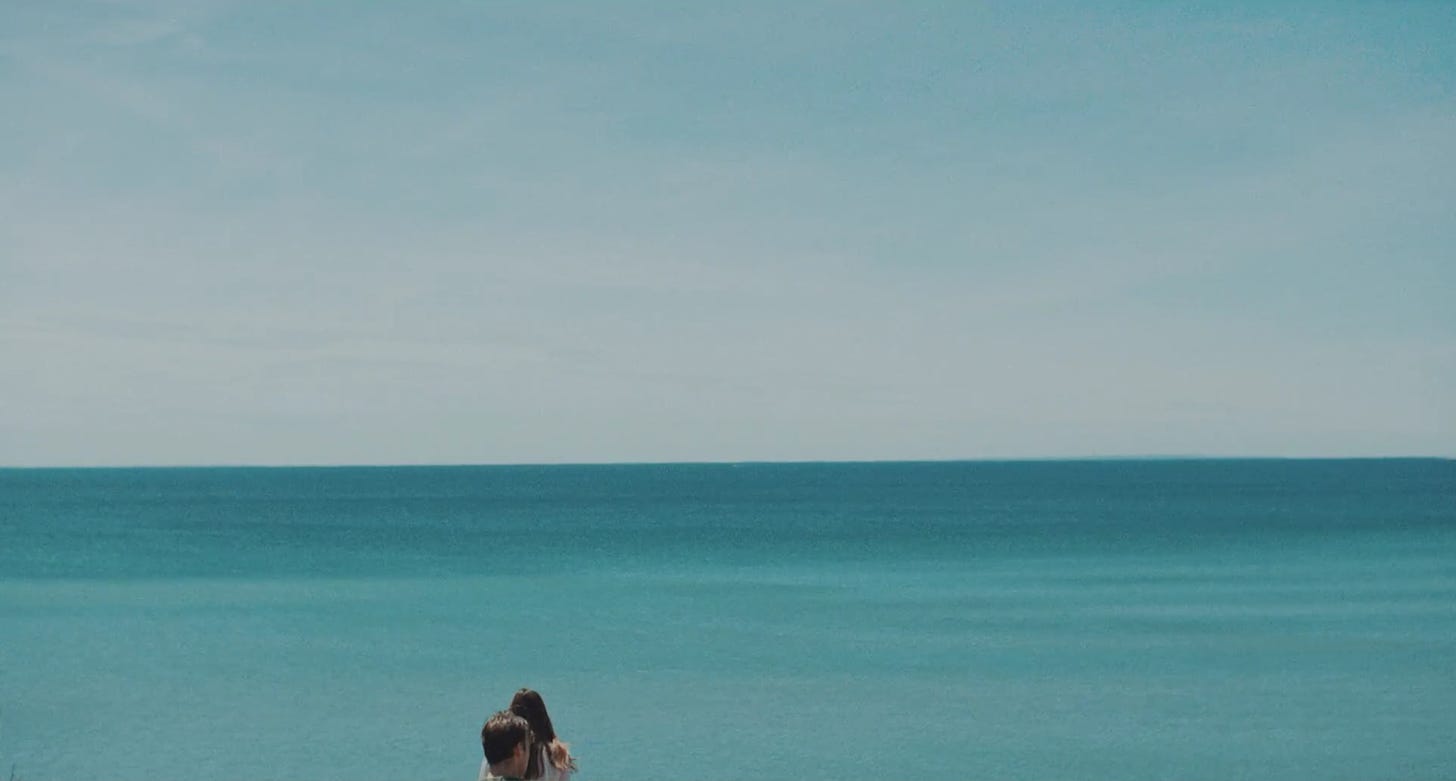
Swimming into the void
One eye-rolly thing is that the story involves white, middle-class people coping with environmental health threats like toxic air and water that, on some level, poor and marginalized communities have been actually living with since the dawn of industry. But I think that’s actually key to the story, which is that these four people, one young couple and another on the far side of middle age, have largely viewed their environment as a source of comfort or play, and it’s now attacking them for the first time. A little before he takes his long walk off a short beach, Mitch realizes that the vacation town is eerily vacant (it is because everyone is dead).
“It was always so beautiful here, but this time, I don’t know, something is off. The thing we liked about coming here was that it was so comfortable. The same weather, the same rooms, the same furniture. They were frozen in time.”
Things certainly are off, but before things get killer-oyster, skin-falling-off bad, the generational differences are hashed out in a weed-and-wine-infused dinner party. Our hero Emily’s spoiled on and off boyfriend Randall, who I imagine having spent a lot of time harassing people on red rose Twitter, wants to retreat from society; he’s dropped out of college and wants Emily to come live in his parents’ vacation home with him indefinitely. “What’s the point of an education? Just to get a job? There has to be something else. What’s underneath all of this. Marriage, kids, taxes, bills, watching television, bills, sports on Sunday.”
He calls Emily’s grad school aspirations “bullshit,” but they are anything but to her. She studies organic chemistry, focusing on origins of life, giving her a kind of warm stoicism about our place in geological history, as she describes a universe mostly hostile to life as we know it. "Life is so fragile. We’re the right combination of elements, the temperature, the right distance from the sun.… One thing slightly off and we would be nothing. Dust or gas or something. I’m in awe of it.”
For the older couple Mitch and Jane, there’s a kind of willful, but not entirely unsympathetic disconnect with reality. They just want things to be the way they were before, and the fact that they are changing is terrifying to them, exacerbated by the fact that Jane is sick and dying. “You kids today, how you see the world. It’s so different. All the information out there. It’s scary,” Mitch says to Emily. "I think that’s why I put my head down and focus on our baseball team."
“Don’t be scared,” she says. “The doors that could be opened because of that information, it should make life more beautiful.”
We’re made to feel that her optimism and openness to whatever the future holds is admirable, but the story’s end leaves us a darker message.
—
An underlying theme in The Beach House is that there’s a narrow set of planetary circumstances that make it possible for human life to thrive, and those circumstances are not guaranteed. This is also a core message behind David Wallace-Wells’ The Uninhabitable Earth, which I happened to be reading when I watched this movie. I have no idea if Jeffrey Brown was influenced by this book, but they both speak to a certain flavor of climate dread.
The book is based on Wallace-Wells’ feature by the same name, which made a huge impact in climate communications for being one of the first popular articles that unflinchingly spelled out the worst case scenarios of climate change. I didn’t love everything about it (until the afterword, he keeps more of a writerly distance from assigning blame and heroism than I prefer), but it’s a beautifully written, affecting book.
Deliberately alarmist, I think it got kind of miscast as a science book that’s predicting the future, when really it’s more of a philosophical thought experiment, teasing out the extremes to reframe the way we think about climate change. He pushes the boundaries of our expectations to kind of knock loose the mental and emotional block many people have constructed around the issue.
One such extreme that already feels closer than when the book published is the loss of some base level of comfort and dependability in our environment. As Wallace-Wells writes:
Governor Jerry Brown first described the state of things in the midst of the state’s wildfire disaster: “a new normal.” The truth is actually much scarier. That is, the end of normal; never normal again. We have already exited the state of environmental conditions that allowed the human animal to evolve in the first place, in an unsure and unplanned bet on just what that animal can endure. The climate system that raised us, and raised everything we now know as human culture and civilization, is now, like a parent, dead.
In one of my favorite climate books, by Elizabeth Kolbert, she makes a similar observation, that if you go back far enough into the climate record, humans weren’t able to develop into what we think of as civilization until all of our ingenuity and unique talents were finally paired with an amenable climate, which emerged about 10,000 years ago. In planetary time, that’s a blip.
Another form of climate terror, illustrated in The Beach House’s barrage of threats coming from air, land, and sea, is the idea that since industrialization, but especially in the past 30 years, humanity’s carbon emissions have been equipping the planet with an arsenal to attack us with. Wallace-Wells again:
However sanguine you might be about the proposition that we have already ravaged the natural world, which we surely have, it is another thing entirely to consider the possibility that we have only provoked it, engineering first in ignorance and then in denial a climate system that will now go to war with us for many centuries, perhaps until it destroys us. That is what Wally Broecker, the avuncular oceanographer, meant when he called the planet an “angry beast.” You could also go with “war machine.” Each day we arm it more.
The world is not just changing irrevocably, it is actually turning against us. And the absolute worst-case scenario at the end of one long and dark potential timeline is what he calls “zero earth,” or “the livable planet darkening as it approaches a human dusk.”
To be clear, Wallace-Wells doesn’t expect this outcome to occur, and is more optimistic than you might expect. But the fact that “we have brought that nightmare eventuality into play at all is perhaps the overwhelming cultural and historical fact of the modern era.”
I actually kept thinking while reading this book that it is a fitting companion to Eugene Thacker’s Horror of Philosophy trilogy, starting with In the Dust of This Planet (Wallace-Wells even seems to slyly reference the book at one point). Maybe his most famous concept is his formulation of three worlds. The world-for-us describes the world as we experience it and are a part of it, the thing we walk around in all day tra la la off to the store to get some food. The world-in-itself is the world that doesn’t really give a shit about us, “which often ‘bites back,’ resists, or ignores our attempts to mold it into the world-for-us.” That is the one that is dealing us these blows, setting loose deadly microbes to ruin our vacations.
Finally, there is the world-without-us, the world that exists outside of human experience. For Thacker, this world is always there just beyond our comprehension, and the terror of its inaccessibility is a big part of his writing. But it also describes the world in which humans are one day extinct. Climate change is forcing us to bump up against the idea of a world-without-us.
Part of the difficulty in relating to a planetary problem like climate change is that it smooshes together all of these worlds in stressful ways. The world we try to shape to our will, the world that bites back at us, and the world in which are not even a thing. We are heroes, villains, and a speck of dust, all at once.
—
What do we do with this knowledge? How do we walk around and live as ordinary people who gotta figure out what to have for dinner? The Uninhabitable Earth explores this to an extent, discussing what shape ethics and politics might take in the future, and how we will make sense of this growing societal dread. He talks about the emergence of “climate nihilism,” and writes, not very fondly, of the Paul Kingsnorths who argue for submission and retreat. These are the petulant Randalls of the world, who want to give up and live in a vacation home, or the exasperated Mitches, starting a slow, mindless swim into oblivion.
I think this section of The Uninhabitable Earth is the least successful, but probably because it asks the hardest questions. You can feel the author’s inner-conflict, just as it’s probably apparent that I don’t have much of a clear outlook here myself. I honestly really like the way Thacker’s nihilism decenters and humbles humanity. The acceptance of it is calming. But I find the self-congratulatory withdrawal of writers like Jonathan Franzen to be revolting. (Mary Annaïse Heglar calls them “the sadbois.”) I guess I’m trying to sort out the path from dread, to acceptance, to resolve.
At the end of The Beach House, Emily’s efforts to escape the infection ultimately fail, leaving us with an outcome as ambiguous as our own. The implication is that this is an extinction event, although with a hint that life is merely being transformed into something new. In the final scene we see her lying on the beach, eyes milky white, repeating to herself what she said to Mitch as he looked to the future in fear. “Don’t be scared, don’t be scared, don’t be scared, don’t be scared,” and then a wave crashes over her, leaving nothing behind.
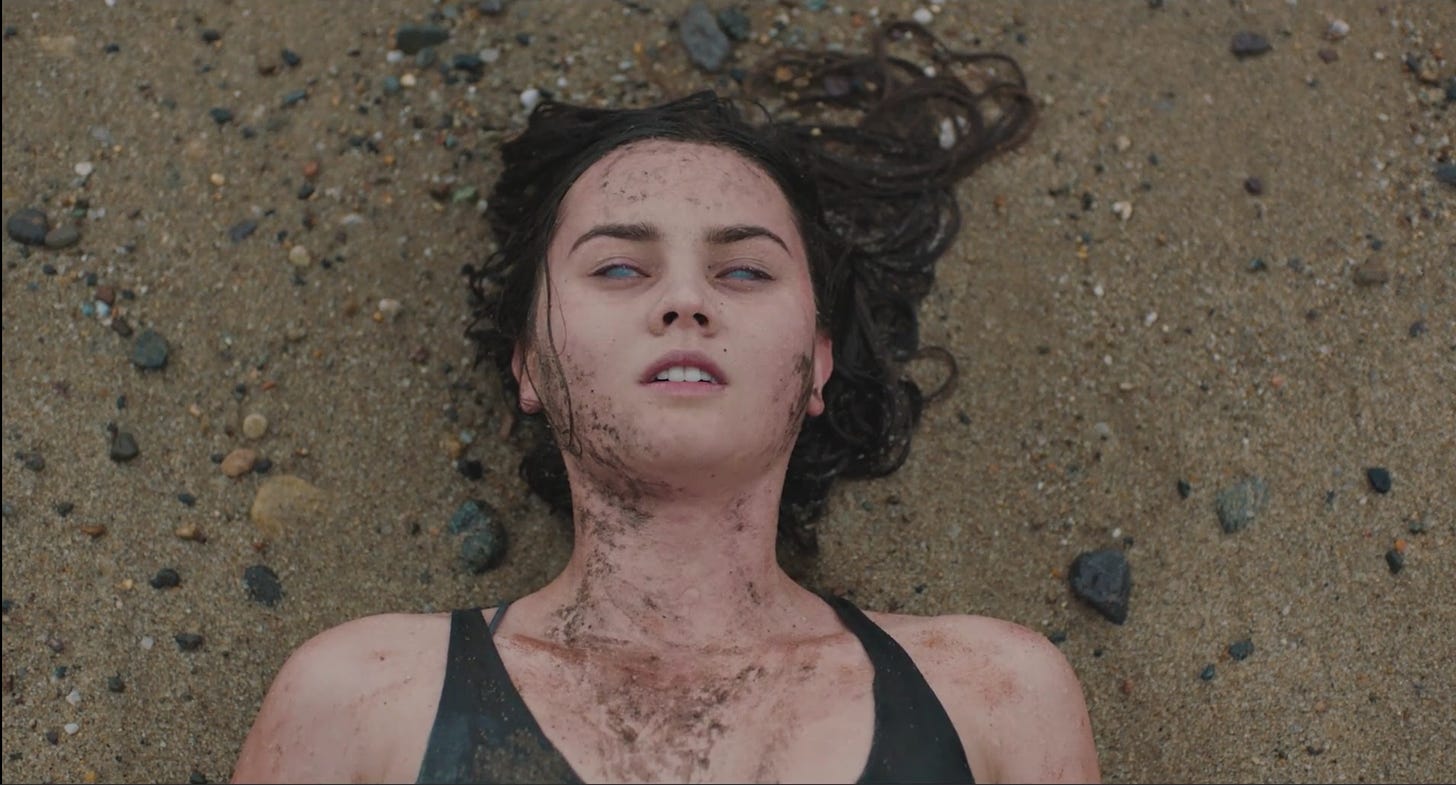
Reading
Mexican Gothic, by Silvia Moreno-Garcia.
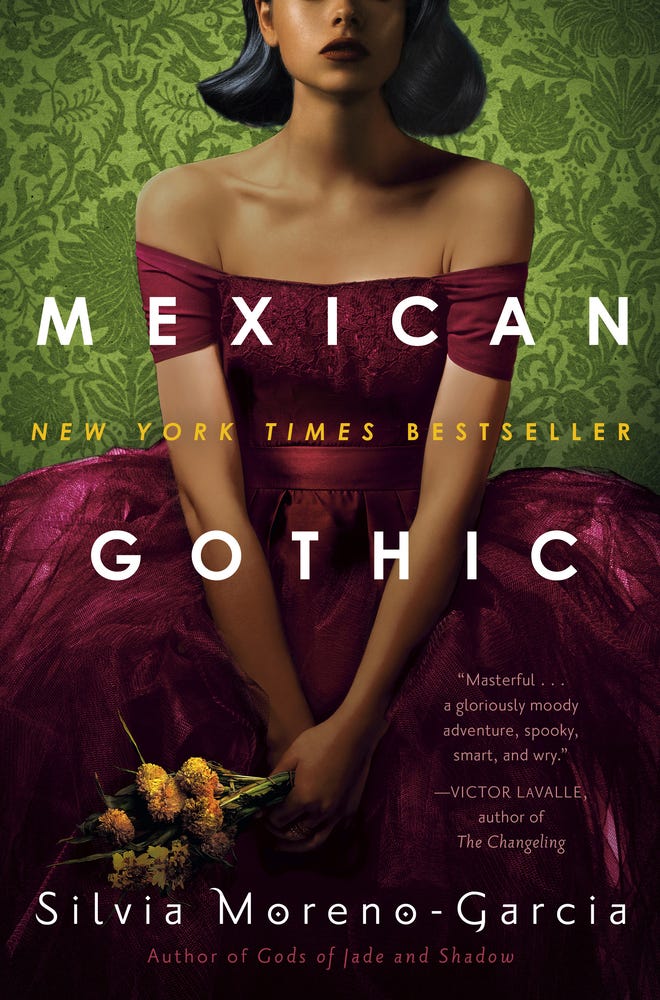
Listening
You can listen to my running scary music playlist on Spotify here, which has some new additions this year including this song.
And this song.
Watching
I’ve mentioned before that every October I watch nothing but scary movies. I watched more than usual this month, a pretty incredible 26 and counting, as a result of far more time spent trapped in the house than in typical years. Horror movies are weird because sometimes the best ones aren’t scary and the worst ones are scary and sometimes you like them even if they aren’t that good or that scary. The majority of the movies I watched this month were so-so, as it goes, but some good ones, including:
Blood Quantum (thanks Theresa)
Host (not The Host, which is also very good)
What Keeps You Alive
Night of the Demons
The Ritual
Phase IV
Scare Me
Ready or Not
Black Water
Relic
Well, I have to say, this is certainly the scariest Halloween I can recall. Downright terrifying. No links this week just because. Voting, calling, texting, worrying, worrying.
Marc Maron said in an email last week, “We are actually scared for our lives in so many ways. So if you are experiencing fatigue, increased heart rate, rapid breathing, sweating, trembling, weakness, trouble concentrating, trouble sleeping, gastrointestinal issues, panic, dizziness, aches and pains, grinding of your jaw, headaches, loss of appetite, increase of appetite and/or muscle tension it might just be an unconscious response to life and what is happening in the world right now.”
I know this sentiment has been expressed a lot lately, but I like how Marc listed off the actual symptoms I found that helpful.
I obviously have no idea what’s going to happen next week and it may be a different world of sorts when I send the next newsletter. But you know what, after Tuesday, you will be here and I will be here, and this will be our home and we will be surrounded by people we love and who love us back, no matter what. Don’t be scared.
Tate


